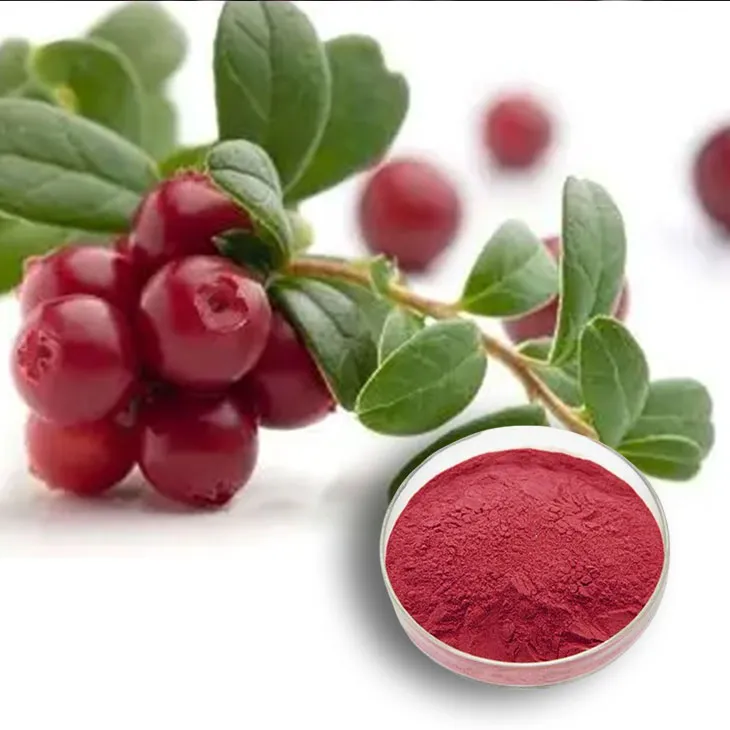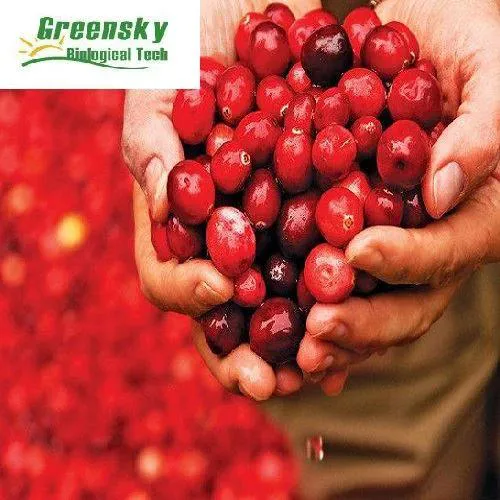- 0086-571-85302990
- sales@greenskybio.com
Cranberry Extract: Uses, Advantages, and Manufacturing Processes
2024-11-14

1. Introduction
Cranberries are small, red berries that are native to North America. They have been used for centuries by Native Americans for both food and medicinal purposes. Cranberry Extract, which is derived from these berries, has gained significant attention in recent years due to its various uses and potential health benefits. This article will explore the uses, advantages, and manufacturing processes of Cranberry Extract.

2. Uses of Cranberry Extract
2.1 In the Food Industry
Cranberry extract is widely used in the food industry as an ingredient in various products. One of its main uses is in the production of jams and jellies. The tangy taste of cranberry extract adds a unique flavor profile to these products, making them more appealing to consumers. It is also used in baked goods such as muffins, cakes, and cookies. The addition of cranberry extract can enhance the flavor and also provide a natural color to these baked items.
2.2 In the Pharmaceutical Field
The pharmaceutical industry has shown great interest in cranberry extract due to its potential health - promoting properties. Research is currently ongoing to explore its use in preventing and treating certain diseases related to bacterial infections and inflammation. For example, cranberry extract may be effective in preventing urinary tract infections (UTIs). The anti - microbial components in cranberry extract can inhibit the growth of bacteria, particularly Escherichia coli (E. coli), which is a common cause of UTIs. Additionally, cranberry extract may also have anti - inflammatory effects, which could be beneficial in treating conditions such as arthritis.

3. Advantages of Cranberry Extract
3.1 Sustainability
One of the significant advantages of cranberry extract is its sustainability. Cranberries are typically grown in bogs, which are wetland areas. These bogs are often managed in an environmentally friendly manner. The cultivation of cranberries requires less water compared to some other crops, and the use of pesticides and fertilizers can be minimized. This makes cranberry extract a more sustainable ingredient option for various industries.
3.2 Immune - Boosting Potential
Cranberry extract contains antioxidant and anti - microbial components that may contribute to its immune - boosting potential. Antioxidants help to protect the body's cells from damage caused by free radicals, which are unstable molecules that can cause oxidative stress. By reducing oxidative stress, cranberry extract may support the immune system. The anti - microbial properties of cranberry extract can also help to fight off infections, further enhancing the body's immune defenses.
3.3 Natural Composition
The natural composition of cranberry extract makes it suitable for a wide range of consumer products. It can be used in both food and health supplements without the need for synthetic additives or preservatives. This is appealing to consumers who are increasingly looking for natural and clean - label products. Cranberry extract can be easily incorporated into various formulations, allowing for its use in different product categories.

4. Manufacturing Processes of Cranberry Extract
4.1 Collection of Fresh Cranberries
The manufacturing process of cranberry extract begins with the collection of fresh cranberries. Cranberries are typically harvested in the fall when they are fully ripe. The harvesting methods can vary, but they are often mechanically harvested to ensure efficiency. Once harvested, the cranberries need to be processed quickly to preserve their quality.
4.2 Mechanical Processes
After collection, the cranberries are subjected to several mechanical processes. Grinding is one of the initial steps, where the cranberries are broken down into a pulp. This helps to release the juices and other components within the berries. Pressing is another important mechanical process. During pressing, the pulp is squeezed to extract the initial liquid. This liquid contains a mixture of water, sugars, acids, and other bioactive compounds present in cranberries.
4.3 Chemical Processes
To further purify and concentrate the cranberry extract, chemical processes may be employed. Acid - base extraction is one such method. In this process, acids and bases are used to adjust the pH of the cranberry liquid, which can help to separate different components. Enzymatic extraction is also used in some cases. Enzymes are added to the cranberry liquid to break down complex molecules into simpler ones, making it easier to extract and purify the desired components. These chemical processes can enhance the quality and potency of the cranberry extract.
4.4 Quality Assurance
Quality assurance is a crucial part of the manufacturing process of cranberry extract. At various stages of production, tests are carried out to check for contaminants such as pesticides, heavy metals, and microbial pathogens. Additionally, accurate measurement of active ingredients is also performed. This ensures that the cranberry extract meets the required quality standards and is safe for consumption. Quality control measures also include proper packaging and storage of the extract to maintain its stability and potency.

5. Conclusion
Cranberry extract has a wide range of uses in the food and pharmaceutical industries. Its advantages, including sustainability, immune - boosting potential, and natural composition, make it an attractive ingredient. The manufacturing process of cranberry extract involves several steps, from the collection of fresh cranberries to mechanical and chemical processes, followed by strict quality assurance. As research on cranberry extract continues, it is likely that more uses and benefits will be discovered in the future.
FAQ:
What are the main uses of cranberry extract in the food industry?
Cranberry extract is used as an ingredient in jams, jellies, and baked goods in the food industry. It enhances the flavor profile of these products with its characteristic tangy taste.
What potential does cranberry extract have in the pharmaceutical field?
In the pharmaceutical field, research is ongoing into cranberry extract's potential use in preventing and treating certain diseases related to bacterial infections and inflammation.
What are the advantages of cranberry extract?
Cranberry extract has several advantages. It is a sustainable ingredient as cranberries are grown in an environmentally friendly manner. It also has the potential to boost the immune system due to its antioxidant and anti - microbial components. Its natural composition makes it suitable for a wide range of consumer products, from food to health supplements.
What are the steps in the manufacturing process of cranberry extract?
The manufacturing process of cranberry extract starts with the collection of fresh cranberries. Then, mechanical processes such as grinding and pressing are used to extract the initial liquid. Chemical processes like acid - base extraction or enzymatic extraction can be employed to further purify and concentrate the extract. Quality assurance, which includes tests for contaminants and accurate measurement of active ingredients, is carried out at various stages.
Why is quality assurance important in the manufacturing process of cranberry extract?
Quality assurance is crucial in the manufacturing process of cranberry extract because it ensures the safety and effectiveness of the final product. Tests for contaminants and accurate measurement of active ingredients are carried out at various stages to make sure the product meets the required standards.
Related literature
- The Health Benefits of Cranberry Extract: A Comprehensive Review"
- "Cranberry Extract in Food and Pharmaceutical Industries: Production and Applications"
- "Manufacturing Processes of Botanical Extracts: The Case of Cranberry"
- ▶ Hesperidin
- ▶ citrus bioflavonoids
- ▶ plant extract
- ▶ lycopene
- ▶ Diosmin
- ▶ Grape seed extract
- ▶ Sea buckthorn Juice Powder
- ▶ Beetroot powder
- ▶ Hops Extract
- ▶ Artichoke Extract
- ▶ Reishi mushroom extract
- ▶ Astaxanthin
- ▶ Green Tea Extract
- ▶ Curcumin Extract
- ▶ Horse Chestnut Extract
- ▶ Other Problems
- ▶ Boswellia Serrata Extract
- ▶ Resveratrol Extract
- ▶ Marigold Extract
- ▶ Grape Leaf Extract
- ▶ blog3
-
High purity olive leaf extract
2024-11-14
-
Lavender oil extraction method
2024-11-14
-
100% organic virgin sea buckthorn fruit oil
2024-11-14
-
Lotus leaf extract powder factory in China
2024-11-14
-
China aged garlic extract supplier
2024-11-14
-
Deer antler extract powder manufacturer
2024-11-14
-
Saw palmetto extract vs whole herb
2024-11-14
-
Yam Extract
2024-11-14
-
Rose Hip Extract
2024-11-14
-
Peppermint Extract Powder
2024-11-14
-
Hops Extract
2024-11-14
-
Moringa powder
2024-11-14
-
Pomegranate Extract
2024-11-14
-
Artichoke Extract
2024-11-14
-
Cat Claw Extract
2024-11-14
-
Hawthorn Extract
2024-11-14
-
Cactus Extract
2024-11-14





















